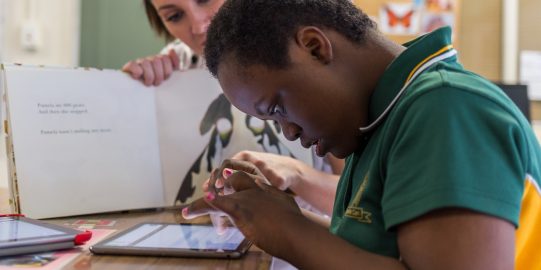There are many reasons that someone may start using Augmentative and Alternative Communication (AAC).
We are often asked: Will AAC stop a person from learning to speak? Different team members are concerned about introducing alternative forms of communication. They worry it will reduce speech attempts. They wonder if it stop the person from learning to speak or even trying to speak.
Research and clinical experience demonstrates that using AAC does not stop an AAC user from learning to speak.
Each person responds to AAC in different ways. A few may have reactions to AAC that are not consistent with research. However, we can be confident that for the great majority of people, AAC has no effect on speech development. Instead, people who use AAC may make gains and improvements in their speech. AAC provides a way to communicate more clearly. Using AAC can reduce frustration and help language development.
The research
Here are two of the most often cited articles:
"The Impact of Augmentative and Alternative Communication Intervention on the Speech Production of Individuals With Developmental Disabilities: A Research Review" by Diane C. Millar, Janice C. Light and Ralf W. Schlosser in Journal of Speech, Language, and Hearing Research, April 2006, Vol. 49, 248-264. doi:10.1044/1092-4388(2006/021)
This article presents the results of an analysis to determine the effect of AAC on the speech production of individuals with developmental disabilities. They conducted a comprehensive search of the literature published between 1975 and 2003. They looked at data on speech production before, during, and after AAC intervention.
"The present research review provides important preliminary evidence that augmentative and alternative communication interventions do not inhibit speech production; instead, AAC may also support speech production.”
"Effects of Augmentative and Alternative Communication Intervention on Speech Production in Children With Autism: A Systematic Review" by Ralf W. Schlosser and Oliver Wendt in American Journal of Speech-Language Pathology, August 2008, Vol. 17, 212-230. doi:10.1044/1058-0360(2008/021)
This systematic review aimed to determine the effects of AAC intervention on speech production in children with autism. They searched for studies written between 1975 and May 2007 using various sources and searches. They analysed participant characteristics, treatment characteristics, and outcomes.
"Results indicated that AAC interventions do not impede speech production. In fact, most studies reported an increase in speech production. However, in-depth analyses revealed that the gains were rather modest."
Multimodal communication - Speech and AAC
All AAC users rely on a variety of ways to communicate. They will use their AAC system, facial expressions, vocalizations, signs, and gestures. They will also use whatever speech they are able to produce. They use what works best to get their message across clearly and quickly.
In practice, we know that speech is a faster and more efficient means of communication than an AAC system. This means that when an AAC user can use speech for a message, it is likely that he or she will use speech.
Use of speech is often more successful when it’s supported with an AAC system. For example, if the speech is unclear, the AAC system can be used to clarify the message. This can provide a more positive experience for the AAC user than using speech alone.
Most importantly, we want people with limited speech to be able to express themselves successfully, by whatever means available to them. We should value and respect all their ways to communicate. The power of AAC is that it can give a person with limited speech more words and language. It makes it possible to communicate far more than they can with speech alone.
Overcome the Roadblock
Giving someone AAC will not stop them from learning to speak. There is so much to be achieved when we give a voice to AAC users!
Take the test: Check the Learn AAC Guide to see where you are in establishing AAC for an AAC user. This may help you overcome any roadblocks stopping you from success!
Links & References
The following are additional research articles supporting this position:
- Baumann Leech, E. & Cress, C. (2011). Indirect Facilitation of Speech in a Late Talking Child by Prompted Production of Picture Symbols or Signs. Augmentative and Alternative Communication, 27 (1), 40-52.
- Blischak, D. M. (1999). Increases in natural speech production following experience with synthetic speech. Journal of Special Education Technology, 14, 4453.
- Blischak, D., Lombardino, L., & Dyson, A. (2003). Use of Speech-Generating Devices: In Support of Natural Speech. Augmentative and Alternative Communication, 19 (1), 29-35.
- Cress, C., & Marvin, C. (2003). Common Questions about AAC Services in Early Intervention. Augmentative and Alternative Communication, 19(4), 254-272.
- King, A., Hengst, J., & DeThorne, L. (2013). Severe Speech Sound Disorders: An Integrated Multimodal Intervention. Language, Speech, and Hearing Services in Schools, 44, 195-210.
- Millar, D., Light, J., & Schlosser, R. (2006). The Impact of Augmentative and Alternative Communication Intervention on the Speech Production of Individuals With Developmental Disabilities: A Research Review. Journal of Speech, Language, and Hearing Research, 49, 248-264.
- Romski, M. & Sevcik, R. (2005). Augmentative Communication and Early Intervention: Myths and Realities. Infants and Young Children, 18(3), 174-185.
- Romski, M., Sevcik, R., Adamson, L., Cheslock, M., Smith, A., Barker, R., & Bakeman, R. (2010). Randomized Comparison of Augmented and Nonaugmented Language Interventions for Toddlers With Developmental Delays and Their Parents. Journal of Speech, Language, and Hearing Research, 53, 350-364.
- Sigafoos, J., Didden, R., & O'Reilly, M. (2003). Effects of Speech Output on Maintenance of Requesting and Frequency of Vocalizations in Three Children with Developmental Disabilities. Augmentative and Alternative Communication, 19(1), 37-47.
- Schlosser, R. & Wendt, O. (2008). Effects of Augmentative and Alternative Communication Intervention on Speech production in Children with Autism: A Systematic Review. American Journal of Speech-Language Pathology, 17, 212-230.




